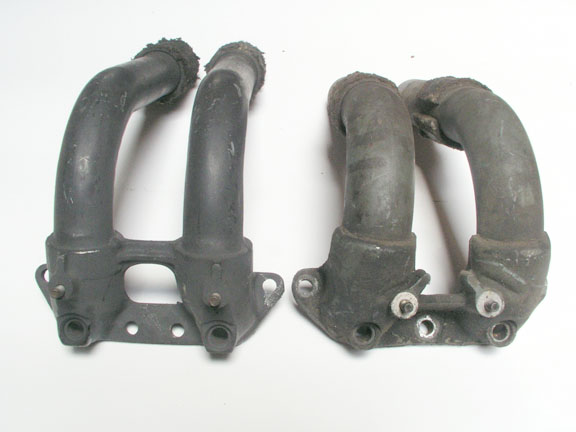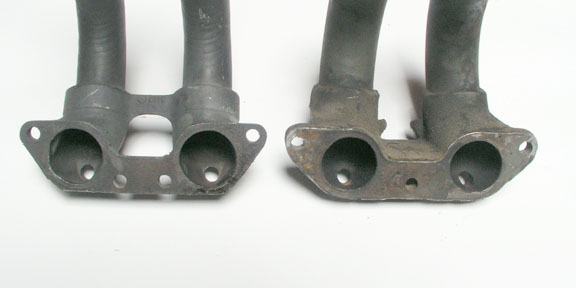Page 2 of 2
Posted: Sun Mar 18, 2007 8:33 am
by Amskeptic
germansupplyscott wrote:
the intake runners are much larger than bus ones.
??
Posted: Sun Mar 18, 2007 8:50 am
by germansupplyscott
internal diameter of the 914 2.0 runner is about 5mm larger than the bus runner. look at the bus runners, where they connect to the plenum, they are flared out to a larger size where the rubber boots attach:

the 914 2.0 runners are this larger diameter along their entire length. this is one of the reasons (along with camshaft, higher CR) that the 914 2.0 was able to make 100hp while the bus was limited to under 70.
the runners in the left of this photo look to me like they are the large internal diameter ones:

Posted: Sun Mar 18, 2007 9:26 am
by Amskeptic
Under magnification, they too have the flare, but I can't tell if they are more subtly flared. The attachments to the intake ports are identical across the line-up of four-stud intake manifolds.
I'd be curious to track this down after I pay you for that oil pump TODAY.
Colin
(my machinist fell asleep on the job while I was driving all across the country and has not even STARTED on my balancing blue-printing)
Posted: Sun Mar 18, 2007 10:21 am
by germansupplyscott
bus on the left, 914 2.0 on the right.



as you said, the intake port size is the same, or nearly so. but the volume of the runner is much larger on the 914 2.0 intake.
Posted: Wed Mar 21, 2007 7:49 am
by Bleyseng
The bus intakes are sized the same as the 1.7L engines while the 914 2.0L are much larger. Why? larger valves-42x36. If you run larger valves the larger intake should make more hp. I haven't tried it yet...but soon. Intake size for FI is sized by the valve size.
Posted: Wed Mar 21, 2007 8:11 am
by Amskeptic
Learning. . . is a never-ending process.
The largest valves on the bus engines are 42mm intakes found on the 1800 carbureted engines. Then they dropped the intake size back down to 37.5 on the injected 2.0, to keep intake velocity as high as possible for fuel atomization? to limit the top end with the thrashy 71mm stroke? Internal intake passage diameters were increased between the 1.7 and 1.8 heads, even though the carbureted intake manifolds remained the same. . . . . .?
Colin
Posted: Wed Mar 21, 2007 9:21 am
by vwlover77
Somewhere there is a retired German engineer that holds the answers to all of our questions!!!!
Posted: Wed Mar 21, 2007 10:50 am
by Sluggo
Too bad that set up was sold a while ago. Now I'm looking for a D-Jet setup for my 411. I've decided to work through my carb problems. As a learning experience if nothing else. I'm a glutton for punishment.
Posted: Wed Mar 21, 2007 5:24 pm
by Bleyseng
A 411 has the same Djet setup as a 914 1.7L so that is easy as we (914club.com) have lots of those to sell. (leftovers)
The actual intake is sized by the exhaust valve size as explained to me. So on a 2.0L bus the exhaust is a 33mm and thats close to the size of the intake!
Based on the airflow numbers of the heads and the intake valves.
Air in= air out.
So the intake charge is setup in the intake runner to be sucked into the chamber and when the intake valve closes has alittle of reversion as possible. The overlap of the valving helps to suck the intake in (exhaust leaving/intake coming in so reversion is important.
Also larger than needed runners slow down the intake charge so its a delicate balance of all the pieces. Sticking the larger 914 2.0L runners on a stock bus should goof up the performance some. I haven't ever tried this but I will be sticking a set of 2.0L 914 runners on my Westy but its doesn't have 42x36 valves.
Posted: Wed Mar 21, 2007 7:50 pm
by Amskeptic
Bleyseng wrote:
The actual intake is sized by the exhaust valve size as explained to me. So on a 2.0L bus the exhaust is a 33mm and thats close to the size of the intake!
Based on the airflow numbers of the heads and the intake valves.
Air in= air out.
There is an important confounding variable here too, and that is the density of the gases. Intake is much more dense with slower velocity by far than the much less dense very hot very fast exhaust.
Bleyseng wrote:
The overlap of the valving helps to suck the intake in (exhaust leaving/intake coming in so reversion is important.
This factor is almost entirely within the province of the cam profile.
Bleyseng wrote:
Also larger than needed runners slow down the intake charge so its a delicate balance of all the pieces.
Extra bad for cold carbureted engines, and not useful for injected engines that need major velocity at the injector tips.
Bleyseng wrote:
Sticking the larger 914 2.0L runners on a stock bus should goof up the performance some. I haven't ever tried this but I will be sticking a set of 2.0L 914 runners on my Westy but its doesn't have 42x36 valves.
The 2.0 engines gave up on the rpm/horsepower game. That was last tried with the 42mm carbureted 1.8, a damn fine engine with good torque and the high rpm horsepower peak of the earlier 1.7. The 2.0 71mm stroke was VW's parallel to BMW's escape from revvy horsepower (with the 2.8 eta engine. Purists hated it, sales doubled here in the U.S. Apparently we like torque.) in favor of much more useable torque at lower revs.
I'd be interested in your torque peak @ X rpms and your total hp @ X rev numbers with the 914 runners.
Colin

